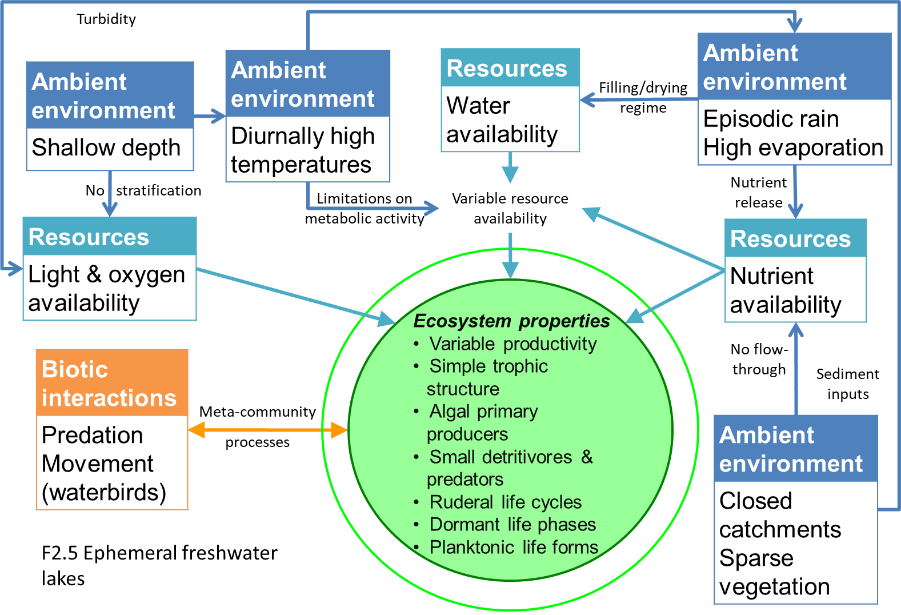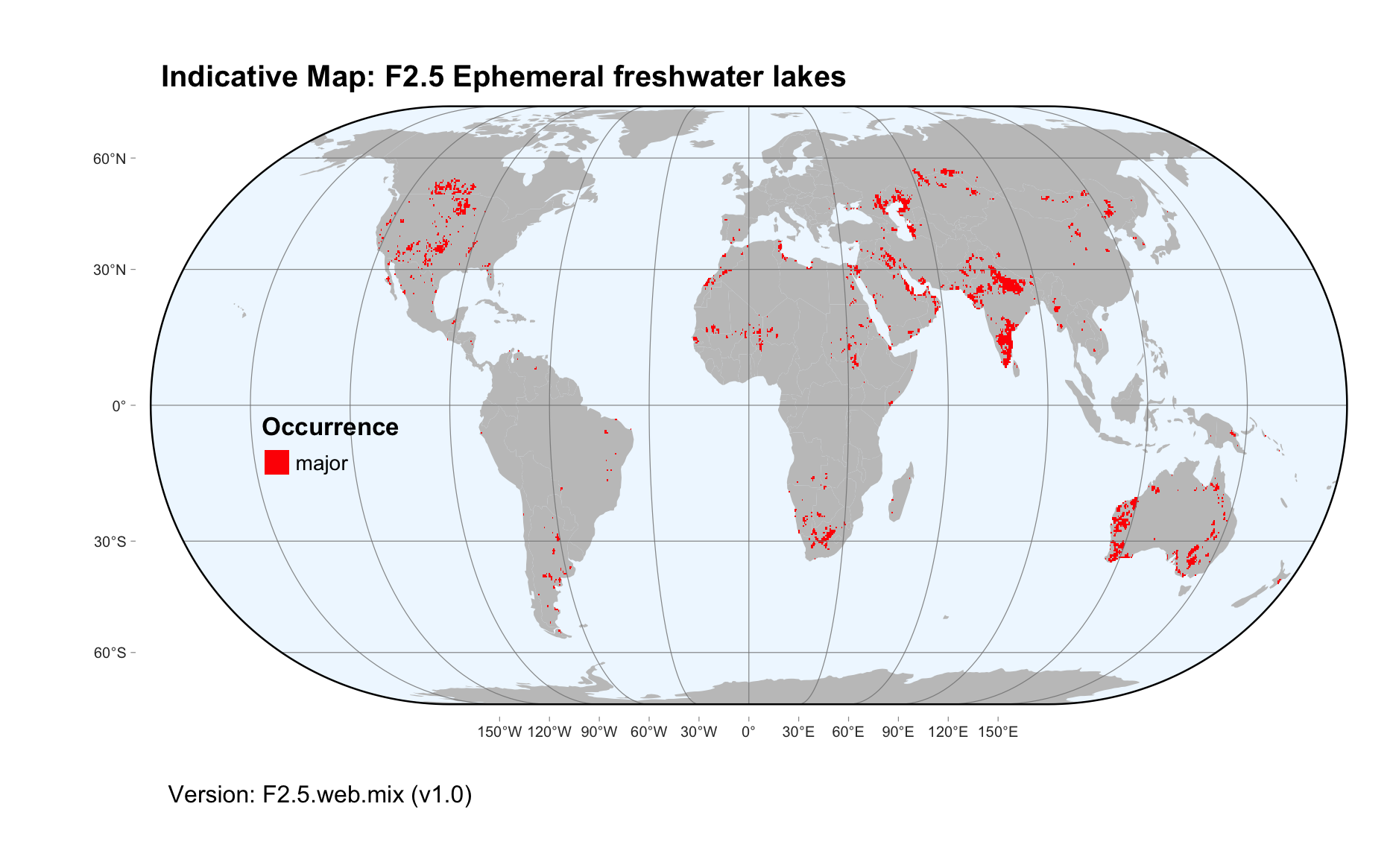Global ecosystem typology
Alternative site for the Global ecosystem typology with additional information for ecosystem profiles and indicative maps.
This site is maintained by jrfep
F2.5 Ephemeral freshwater lakes
Biome: F2. Lakes biome
Contributors:
(texts)
These are shallow lakes that are mostly dry, and then fill for weeks or months, before drying again. During dry periods, many animals or plants survive as eggs, seeds or other dormant forms, while other species disperse. Floods, bring water from surrounding catchments and floodplains with organic matter, nutrients and fine sediments, and trigger movement of birds and mammals. Floods activate simple foodwebs, comprising abundant algae, zooplankton, waterbugs and crustaceans, which have rapid life-cycles able to exploit windows of productivity. This produces food for frogs and visiting waterbirds.
Key Features
Shallow temporary lakes, depressions or pans with long dry periods of low productivity, punctuated by episodes of inflow that bring large resource subsidies from catchments, resulting in high productivity, population turnover and trophic connectivity.
Overview of distribution
Semi-arid and arid regions at mid latitudes of Africa, southern Australia, Eurasia, Europe and western parts of North and South America.
Profile versions
- v1.0 (2020-01-20): DJ Roux; RC Mac Nally; RT Kingsford; DA Keith
- v2.0 (2020-06-24): DJ Roux; R Mac Nally; RT Kingsford; JT Hollibaugh; DA Keith
- v2.01 ():
- v2.1 (2022-04-06): DJ Roux; R Mac Nally; RT Kingsford; JT Hollibaugh; DA Keith Full profile available at official site
Main references
Selected references for this functional group:
Hancock MA, Timms BV (2002) Ecology of four turbid clay pans during a filling-drying cycle in the Paroo, semi-arid Australia Hydrobiologia 479: 95-107
Meintjes S (1996) Seasonal changes in the invertebrate community of small shallow ephemeral pans at Bain’s Vlei, South Africa Hydrobiologia 317: 51-64
Williams WD (2000) Biodiversity in temporary wetlands of dryland regions Internationale Vereinigung für theoretische und angewandte Limnologie: Verhandlungen 27: 141-144
Diagrammatic assembly model

Maps
Maps are indicative of global distribution patterns are not intended to represent fine-scale patterns. The maps show areas of the world containing major (coloured red) or minor occurrences (coloured yellow) of each ecosystem functional group. See general notes on maps.
There are 2 alternative versions of the indicative map for this functional group, please compare description and sources below.
F2.5.IM.mix_v1.0
Datasets
- HydroAtlas-1.0
- GSW-1.1
- HydroLAKES-1.0
- GLWD-2004
Map references
Linke, S., Lehner, B., Ouellet Dallaire, C., Ariwi, J., Grill, G., Anand, M., Beames, P., Burchard-Levine, V., Maxwell, S., Moidu, H., Tan, F., Thieme, M. (2019) Global hydro-environmental sub-basin and river reach characteristics at high spatial resolution Scientific Data 6: 283 DOI:10.1038/s41597-019-0300-6
Pekel JF, Cottam A, Gorelick N, Belward AS (2016) High-resolution mapping of global surface water and its long-term changes Nature 540, 418-422 DOI:10.1038/nature20584
Messager, M.L., Lehner, B., Grill, G., Nedeva, I., Schmitt, O. (2016) Estimating the volume and age of water stored in global lakes using a geo-statistical approach Nature Communications 13603 DOI:10.1038/ncomms13603
Lehner, B. and Döll, P. (2004): Development and validation of a global database of lakes, reservoirs and wetlands. Journal of Hydrology 296/1-4: 1-22. Data-set
F2.5.web.mix_v1.0

Datasets
- HydroAtlas-1.0
- HydroLAKES-1.0
- GLWD-2004
- GSW-1.1
Map references
Linke, S., Lehner, B., Ouellet Dallaire, C., Ariwi, J., Grill, G., Anand, M., Beames, P., Burchard-Levine, V., Maxwell, S., Moidu, H., Tan, F., Thieme, M. (2019) Global hydro-environmental sub-basin and river reach characteristics at high spatial resolution Scientific Data 6: 283 DOI:10.1038/s41597-019-0300-6
Messager, M.L., Lehner, B., Grill, G., Nedeva, I., Schmitt, O. (2016) Estimating the volume and age of water stored in global lakes using a geo-statistical approach Nature Communications 13603 DOI:10.1038/ncomms13603
Lehner, B. and Döll, P. (2004): Development and validation of a global database of lakes, reservoirs and wetlands. Journal of Hydrology 296/1-4: 1-22. Data-set
Pekel JF, Cottam A, Gorelick N, Belward AS (2016) High-resolution mapping of global surface water and its long-term changes Nature 540, 418-422 DOI:10.1038/nature20584
Check: the Glossary / Profile structure / the public document